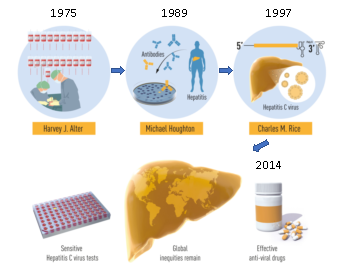The 2020 Nobel Prize in Physiology or Medicine is awarded to Harvey J. Alter (NIH, USA), Michael Houghton (University of Alberta, Canada) and Charles M. Rice (Rockefeller University, USA) for the discovery of Hepatitis C virus (HCV).
Hepatitis is liver inflammation that is mainly caused by viral infections, although drugs, toxins, alcohol, and autoimmune diseases are also important causes.
In 1947, infectious hepatitis was classified into two subtypes: hepatitis A and hepatitis B. The hepatitis A virus (HAV, ssRNA virus) is transmitted by polluted food or water and generally does not progress to a chronic state. In addition, vaccination is highly effective in protecting against HAV infection. The hepatitis B virus (HBV, dsDNA virus) is most commonly transmitted from mother to child during delivery, as well as through contact with blood or other body fluids. Although hepatitis B is a potentially life-threatening and WHO estimates that in 2015, 257 million people were infected with HBV, hepatitis B can be prevented by vaccines. The hepatitis C virus (HCV, ssRNA virus) infected 72 million people in the year of the report and a major cause of liver cancer. However, the discoveries of the Laureates have led to the development of sensitive blood tests and anti-viral drugs that can cure more than 95% of people with HCV infection and have saved millions of lives (Figure).

Figure: Modified from https://www.nobelprize.org/prizes/medicine/2020/summary/
Harvey Alter and coworkers reported in 1975 that a substantial fraction of non-B hepatitis cases were not caused by HAV or any other known virus and named “non-A, non-B hepatitis (NANBH) (Lancet 1975, 2(7940):838-841). Alter also showed that serum from patients with acute or chronic NANBH could transmit the disease to chimpanzees, providing an animal model.
Michael Houghton, working at Chiron Corporation, initiated his hunt for the NANBH virus in 1982 using a molecular approach based on the screening of DNA fragments. In 1989, he and coworkers finally isolated a cDNA clone derived from NANBH genome and named HCV (Science 1989, 244(4902):359-362). Following identification of the virus, the Houghton team rapidly developed an immunoassay for the detection of HCV-specific antibodies.
Charles Rice, working at Washington University in St Louis, provided conclusive evidence that HCV alone could cause hepatitis (Science 1997, 277(5325):570-574).
The development of drugs that specifically target the viral RNA-dependent RNA polymerase NS5B, e.g. sofosbuvir, and the regulatory replicon protein NS5A, e.g. ledipasvir, constituted major breakthroughs in HCV therapeutics. The combination of these drugs proved to be highly effective (Lancet 2019, 393(10179):1392-1394), but access to diagnosis and treatment is still low. In addition, there is currently no effective vaccine against HCV.
Written by Fumihiko Nakamura, SPST, TJU

